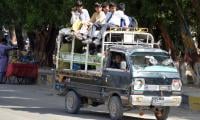Independent candidates and the ruling PTI dominated the provincial elections held for the first time in the seven tribal districts and six Frontier Regions recently merged with Khyber Pakhtunkhwa. Official results show six seats going to independents, five to the PTI, three to the JUI-F and once each to the Awami National Party and Jamaat-e-Islami. One seat in North Waziristan went to a candidate affiliated with the PTM. The results are significant given that they provide an indication of people’s political convictions and thinking in the former tribal areas. Prior to the polls, there were predictions that a large number of people would come forward to cast their first ever votes for the provincial assembly. The 26 percent turnout, however, suggests otherwise.
The number of independent candidates is significant because according to election rules any elected member who declares affiliation with a party within three days of the publication of the official results will count as a member of that party when it comes to deciding the four reserved seats for women and minorities under the proportional representational system. The PTI has also announced it will be taking action against members who contested as independents. These candidates, reflecting displeasure with the official ticket allocation by the party, divided up the PTI vote in some constituencies. The success of independent candidate Shafiq Afridi and his close relative Bilawal Afridi in PK 105 Khyber I and PK 106 Khyber II suggested strong support for the role Shafiq Afridi had played in strongly recommending the merger of the tribal districts into KP. The area is a tradition stronghold for the JUI-F and the PTI, which also benefits from the fact that it is the ruling party in the province. This pattern has been seen consistently in Pakistan with voters hoping rulers will be better able to solve their issues.
Initial analysis suggests that many of those who voted were younger people, excited by the prospect of being involved in the mainstream of Pakistan’s politics. However, there was no clear support for any single party, with voting falling along traditional lines. Candidates who held influence in their areas on the basis of their personal standing tended to do well. This is also something the major political parties will need to think about. They need an agenda that convinces people to cast their votes in favour of these parties and demonstrate confidence in their ability to deliver on their promises. The fact that around 18 percent of women turned out to vote was encouraging given that in these areas political groups have in the past reached agreements barring women from casting ballots. What is more significant for the future is what these elections will bring to the former Fata areas in terms of much needed development work and how people will be served by the candidates they have voted in.
Country witnessed 432 violence-linked fatalities and 370 injuries among civilians, security personnel, and outlaws
During Raisi’s visit, Iran and Pakistan signed a total of eight accords on varying subjects to enhance cooperation...
Every year, millions of girls silently say goodbye to their education and the promise of a better career and get married
Ruling party emerged victorious in by-elections and as per unofficial results has won at least two out of five NA...
According to its organizers, the event now brings together around one billion people across 200 countries every April...
Pakistan’s nuclear programme, it would have threatened peace in the region because of its hegemonic designs







